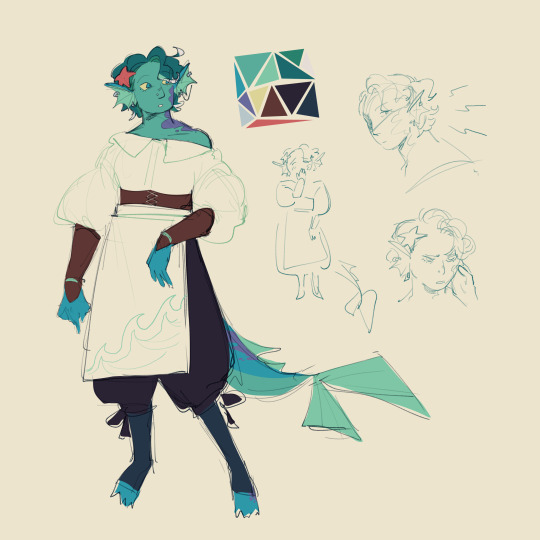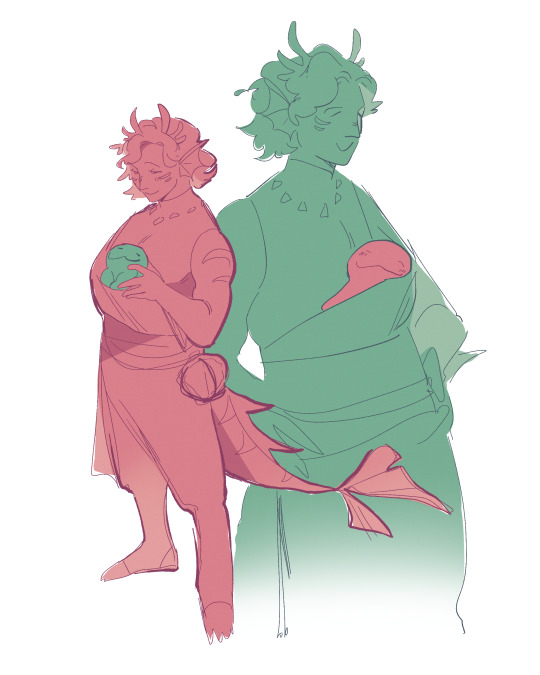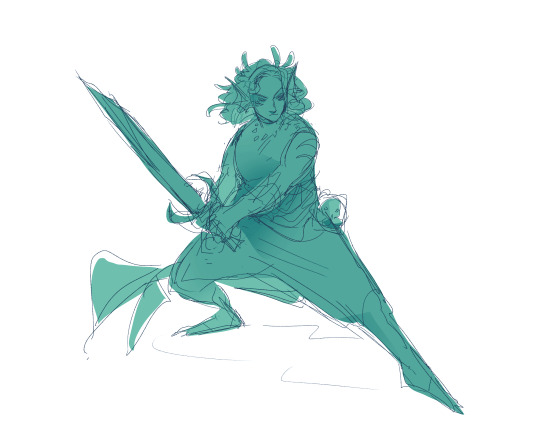#me setting out to settle on a design for any of these fuckers: I CANT KEEP GIVING THEM THE LOOSE POOFY PANTS OR POOFY SLEEVES I NEED TO STO
Text



an edyn design but i will most definitely futz with the outfit when i have brainjuice for it
gill with pretzel babywrap inspired by my brother who listened to maybe half of ep1 and got it in his head that pretzel was tied to his stomach, not on his hip and i screamed when he told me
no thoughts head empty sketch of gill pose
#i feel like ive been posting too many fanarts as like.. their own posts#i kinda like letting them pile up and just dumping them all in one post#but also ive been in a weird art mood where anytime i start smth i never rlly expect it to go anywhere#so i just post it when im done and then it just loops like that#just roll with it#jrwi riptide#edyn tidestrider#gillion tidestrider#jrwi pretzel#my art#me setting out to settle on a design for any of these fuckers: I CANT KEEP GIVING THEM THE LOOSE POOFY PANTS OR POOFY SLEEVES I NEED TO STO#.... 🥺 but it.. its so fun to draw..... the shapes...
474 notes
·
View notes
Text
Photography legend Joel Meyerowitz: phones killed the sexiness of the street
New Post has been published on https://photographyguideto.com/must-see/photography-legend-joel-meyerowitz-phones-killed-the-sexiness-of-the-street/
Photography legend Joel Meyerowitz: phones killed the sexiness of the street
He chased parades, ambushed hairdressers and refused to leave Ground Zero. Over PG Tips and ricotta at his Tuscan barn, Joel Meyerowitz relives his most stunning shots
One day 55 years ago, Joel Meyerowitz was roaming the streets of his native New York with a 35mm camera when he glimpsed something through an arcade window that stopped him in his tracks. A young woman was standing with her back to him, tenderly grooming her boyfriends pompadour with a comb, just as Meyerowitz imagined she had curled the hair of dolls when she was a girl.
As we sit in front of the log fire in his converted barn in Tuscany in the February dusk, Meyerowitz remembers what happened next. I snuck up as close as I could and tried to capture the intimacy of that moment. I was very shy and it took all my courage if the plate glass hadnt been there, maybe I wouldnt have dared get so close. In the resulting print, the boy glances from the shadows into the camera with furrowed brow, a moment of pure vulnerability that a split second later might have curdled into rage at Meyerowitzs intrusion. And, just possibly, the photographer might have got his ass kicked.
Tender grooming New York City, 1962.
This was one of the American street photographers first images. Whats striking about it is not so much the bravura seizing of the moment. Cartier-Bresson, after all, had already made his name doing that and Meyerowitz was following the Frenchmans lead. Rather, it was that the seized moment was in colour. In art photography, there was still this huge prejudice against colour as if only black and white were aesthetically justifiable, he recalls. I never bought that: for me colour is essential; I instinctively felt I needed it to give my work force. Just as we have smell memories, we have colour memories. I mean the world is in colour, right?
Meyerowitz was seduced into photography earlier that year when, as a young art director, he witnessed an ad agency shoot by the great American photographer Robert Frank for a booklet he was designing. The way he weaved in and out of the girls he was shooting, my God, that was a revelation to me. You could move while working the camera. Wow! I wanted to do that, too.
Until that epiphany, Meyerowitz hadnt been sure what he wanted to do with his life. He was studying part time for a masters in art history and dabbling in abstract painting. After seeing Frank at work, however, he went back to the ad agency office that afternoon and quit. Harry, my boss, couldnt believe me. Later, though, he bought me a camera.
How much is that tiger in the window? New York City, 1975
From the start, Meyerowitz and fellow street photographer and friend Garry Winogrand sought to explore the erotics of the street: The heat of the gazes between people, the charged mystery that arises from capturing chance moments on the fly, he says.
In his new autobiographical photography book Where I Find Myself, Meyerowitz writes of those heady days: We loved watching the play of light on Fifth Avenue and how it gave meaning to things. We watched the seasons change and with it womens clothing getting lighter and sexier. We were living and breathing photography We felt we were part of a movement that was making photography more interesting than it ever was before.
But first he had to overcome his shyness. He did this with his initial project taking shots of bystanders at street parades. Nobody thinks theres anything odd about a photographer at a parade, so that gave me invisibility. One particularly successful image taken in New York in 1963 depicts a relaxed, smiling, cardigan-wearing African American man standing with his dog on the pavement next to a tightly wound white man in a suit who is holding his hand to his heart and glaring past the black man.
Seize the chance moments New York City, 1963.
Hes saluting the flag thats off camera, explains Meyerowitz. Its a superbly unresolved image but sets up all kinds of dual tensions black/white, genial/fraught, patriotic/not so much. You need to get on the streets and seize the chance moments, he says.
Of his street images, my favourite depicts a Frenchman who has fallen outside a Paris Mtro station one day in 1967. By this stage, Meyerowitz had started to take longer shots moving back from eight to 20 feet from what he sought to capture. Its a shift from chamber music to symphony. Everybody is looking at the fallen man, the chic young woman descending the station steps, the delivery guy pushing boxes on a trolley, a cyclist swivelling to get a better look at a strangers misfortune. A worker in overalls even steps over the prone man, carrying a hammer that takes on sinister import. Those fuckers, laughs Meyerowitz. Not one of them helps him up.
The image is an absorbing network of gazes and furtive glances. In the 60s and 70s you could look at my street photographs and trace lines from the eyes of people connecting with other peoples eyes, setting up these force fields.
As exotic as a tropical fish Sarah, Provincetown, Massachusetts, 1981
Today, what entranced Joel Meyerowitz about the street is all but dead. Nobodys looking at each other. Everybodys glued to their phones. But street photography still exists? Its thriving but not in the way I used to do it. The best street photographers now show humans dwarfed by ad billboards. The street has lost its savour.
As his work evolved, Meyerowitz became a tougher, indomitable street presence, and yet one like the best photographers able to charm his subjects into giving him what he wants. You can see that in the way he got swimsuited young women to pose guilelessly near his summer home in Provincetown, Massachusetts, for a series of early 80s pictures that prefigured Rineke Dijkstras similar subject matter. How, for instance, he inveigles a red-headed young woman as exotic as a tropical fish to pose for his camera, exposing her freckled arms.
You can see this process most clearly, though, in the pictures Meyerowitz took at Ground Zero. On 9/11 he was out of town, but headed home bent on the idea of photographing the aftermath. When I got to Ground Zero, I had my Leica out and then I got a thump in the back from a cop. They said: You cant take a picture here, buddy, this is a crime scene. Well, I argued with them its a public space, my city, I can do what the fuck I want. And I did.
His subsequent photo essay was a charged memorial to the grandiosity of the ruin, and the people who worked in it, hunting for teeth, bones, anything that might identify victims. The care they invested in this task brought to the vast physical dimensions of the site an intimate, spiritual dimension, he says.
Smoke Rising in Sunlight, New York City, 2001
The following spring, he was in Italy. The world had changed because of 9/11 and so when I saw the thousands of years of continuous cultivation of Tuscan landscape, it was great solace. In Where I Find Myself, Meyerowitz juxtaposes photographs of Ground Zero with the cypresses and fields of Tuscany theres a spiritual dimension to these rural images, too, a renewal by means of natural goodness in the aftermath of evil.
Today, the photographer has definitively swapped the street for the farm, the Bronx for a home in the hills south of Siena. He and his English second wife, the novelist Maggie Barrett, have spent the past four years converting a barn to a rural retreat. Weve uprooted from everything and settled here without family or much in the way of friends, but with each other. Its an experiment in intimacy. We drink tea (his wifes PG Tips) and he serves me week-old ricotta made by the farmer who lives next door.
Meyerowitz has described his urban photography as jazz, a sinuous dance through the streets with a handheld camera. Only later in his career did he add landscape to his repertoire. It happened in Provincetown in the late 70s. I moved every summer to somewhere where life was simple and I started to see differently. And what I saw, I needed to capture with a view camera, an 8×10 camera. With that you dont riff, you dont do jazz. You do what it tells you. So what was the appeal? Everything was rendered with this incredible visual acuity. It blew me away. His Bay/Sky series from the late 70s and early 80s, in particular, purge humans for the essentials of sky, sea and land.
Longnook Beach, Truro, Massachusetts, 1985.
For the past four years, Meyerowitz has retreated from the world into his studio, where he has been photographing humble objects hes picked up from Provenal brocantes and Tuscan junk shops. His work, he thinks, riffs on Czanne and Giorgio Morandis still lifes. Im obsessed with these pictorial puzzles. He started with two or three objects and has now moved on to grand arrangements that remind me of the complicated positioning of humans in his street photos.
Bald, sinewy (half a lifetime ago he missed becoming a US Olympic swimmer by thousandths of a second), and brimming with life, Meyerowitz turns 80 on 6 March. Any plans to retire, I ask, as he shows me out? Artists dont retire. We just move on to new creative obsessions. Well, thats what I do.
Joel Meyerowitz: Where I Find Myself is published by Laurence King on 12 March.
Read more: http://www.theguardian.com/us
0 notes